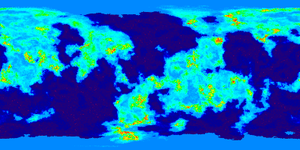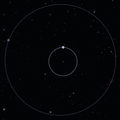Difference between revisions of "Kerbin/pl"
| Line 46: | Line 46: | ||
|} | |} | ||
| − | == | + | == Atmosfera == |
| − | <!-- SPECULATION: Kerbin has an atmosphere of unknown composition, though because Kerbin has plants and animals, it can be assumed there is O<sub>2</sub>, N<sub>2</sub>, and CO<sub>2</sub>. --> | + | <!-- SPECULATION: Kerbin has an atmosphere of unknown composition, though because Kerbin has plants and animals, it can be assumed there is O<sub>2</sub>, N<sub>2</sub>, and CO<sub>2</sub>. --> |
| + | |||
| + | Atmosfera Kerbinu zawiera tlen i rozciąga się an wysokość około 69078 m. Atmosfera zanika wykładniczo wraz ze wzrostem wysokości (współczynnik skali równy 5 km).<ref>{{forum link|threadID=16000|threadName=[KGSS] Examining Kerbin's atmosphere}}</ref> Generalnie gęstość i ciśnienie atmosferyczne Kerbinu na wysokości wyrażonej w metrach to: | ||
: <math>p_k = e^{-altitude/5000}</math> | : <math>p_k = e^{-altitude/5000}</math> | ||
| − | == | + | == Orbity == |
| − | + | Orbita geosynchroniczna jest osiągalna na wysokości | |
| − | {{OrbitAltitude | period_s=21600 | mass_kg=5.29157926281091e22 | radius_km=600 }} (1008.9 m/s). | + | {{OrbitAltitude | period_s=21600 | mass_kg=5.29157926281091e22 | radius_km=600 }} (1008.9 m/s). Orbita semisynchroniczna z okresem orbitalnym równym 1/2 Dnia Kerbinu (3 godziny lub 10800 sekund) jest osiągalna na wysokości |
| − | {{OrbitAltitude | period_s=10800 | mass_kg=5.29157926281091e22 | radius_km=600 }} | + | {{OrbitAltitude | period_s=10800 | mass_kg=5.29157926281091e22 | radius_km=600 }} z prędkością orbitalną równą: |
{{OrbitVelocity | period_s=10800 | mass_kg=5.29157926281091e22 | radius_km=600 }}. | {{OrbitVelocity | period_s=10800 | mass_kg=5.29157926281091e22 | radius_km=600 }}. | ||
| − | == | + | == Podróż Międzyplanetarna == |
| − | + | Z najniższej stabilnej orbity wokół Kerbina (70 km), wartość zmiany prędkości delta-V needed to reach the orbits of other celestials is as follows: | |
{| class="wikitable" | {| class="wikitable" | ||
Revision as of 12:50, 9 December 2012
Kerbin jest to główna planeta Kerbali, posiada Centrum Kosmiczne. Jest odpowiednikiem Ziemi. Posiada 2 księżyceMun i Minmus.
Kerbin jest trzecią planetą orbitującą gwiazdę Kerbol. Jest to trzecia największa planeta (po Jool orazEve) i czwartym co do wielkości ciałem niebieskim ( Tylo księżyc Jool'a jest niewiele większy ).
Osiągnięcie stabilnej orbity nad Kerbinem jest jednym z pierwszych wielkich osiągnięć gracza. Osiągnięcie takiej orbity z trajektorią wznoszenia optymalną z punktu widzenia zużycia paliwa[1] wymaga zmiany prędkości delta-V od4.45 do 4.7 km/s.[2] Dla wielu misji międzyplanetarnych, jest to ponad połowa wymaganej zmiany prędkości delta-V. (podobnie jak dla Ziemskich misji kosmicznych, co jeden z obserwatorów napisał "Jeżeli możesz dotrzeć swoim statkiem na orbitę, jesteś już w połowie drogi w dowolne miejsce."[3])
Contents
[hide]Topografia
|
Powierzchnia Kerbinu jest pokryta wodą i lądem w prawie równych proporcjach. Posiada pokrywy lodowe na biegunach i pustynie rozrzucone po kontynentach. Występują góry przekraczające 3km wysokości, z najwyższym szczytem na wysokości co najmniej 3750 m.[4] Kerbin posiada ślady uderzenia przez asteroidę lub kometę. Jest widoczny duży krater na półkuli zachodniej. Dotyczy wersji v0.18 Nastąpiła zmiana wyglądu Kerbinu w wersji 0.18[5], co przyczyniło się do zmiany topografii. Wszystkie informacje dotyczą wersji 0.17.1, Wyjątkiem jest obrazek powyżej, który jest z 0.18. |
Atmosfera
Atmosfera Kerbinu zawiera tlen i rozciąga się an wysokość około 69078 m. Atmosfera zanika wykładniczo wraz ze wzrostem wysokości (współczynnik skali równy 5 km).[6] Generalnie gęstość i ciśnienie atmosferyczne Kerbinu na wysokości wyrażonej w metrach to:
Orbity
Orbita geosynchroniczna jest osiągalna na wysokości 0,00 m (1008.9 m/s). Orbita semisynchroniczna z okresem orbitalnym równym 1/2 Dnia Kerbinu (3 godziny lub 10800 sekund) jest osiągalna na wysokości 0,00 m z prędkością orbitalną równą: 0,00 m/s.
Podróż Międzyplanetarna
Z najniższej stabilnej orbity wokół Kerbina (70 km), wartość zmiany prędkości delta-V needed to reach the orbits of other celestials is as follows:
| Body | Delta-V | |
|---|---|---|
| Mun | ~860 m/s | |
| Minmus | ~930 m/s | |
| Eve | ~1033 m/s | |
| Duna | ~1060 m/s | |
| Moho | ~1676 m/s | |
| Jool | ~1915 m/s | |
Reference Frames
| Paid (0.17) | Demo (0.13.3) | |
|---|---|---|
| Rotational/Inertial transition | 100,000 m | 70,000 m |
| Warp | Minimum Altitude | |
| 1x | Any | |
| 2x | n/a | 0 m |
| 5x | 69,078 m (above the atmosphere) | |
| 10x | 69,078 m (above the atmosphere) | |
| 50x | 69,078 m | 150,000 m |
| 100x | 120,000 m | 300,000 m |
| 1,000x | 240,000 m | 600,000 m |
| 10,000x | 480,000 m | 1,200,000 m |
| 100,000x | 600,000 m | n/a |
Gallery
- NJ6qJ.jpg
A projection map of Kerbin, as of 0.14.1 and before (including the demo).
Changes
- Terrain overhaul: Entire planet redo. Deserts, darker and greener grass, islands, darker ocean/water, snow capped mountains. Looks more realistic.
- Second KSC removed due to overhaul, 3 new KSCs added.
- Several Easter Eggs added.
- Airport added to island off of KSC coastline. (Not a launching point)
- Improved atmosphere visuals.
- Minmus added.
- Much more varied and taller terrain added. Prior to this, some mountain ranges exceeded 600 m in height, but the tallest point was at an altitude of approximately 900 m.
- Mun added.
- Terrain overhaul, oceans became wet.
- Atmosphere extended from ~34,500 m to ~69,000 m.
- Initial Release
Notes
- Jump up ↑ Trajektoria wznoszenia optymalna dla zużycia paliwa to taka, która (a)minimalizuje straty prędkości spowodowane tarciem atmosfery i oddziaływaniem grawitacyjnym i (b) jest skierowana na wschód (kierunek 90 stopni), dzięki czemu pojazd zyskuje 174.5 m/s prędkości orbitalnej za darmo dzięki rotacji planety.
- Jump up ↑ Zmiana prędkości Delta-V na kerbinie
- Jump up ↑ Robert Heinlein, cytat ze strony 194 A Step Farther Out Autor: Jerry Pournelle.
- Jump up ↑ http://kerbalspaceprogram.com/forum/index.php?topic=11388.msg176509#msg176509 Template:Link zepsuty
- Jump up ↑ http://forum.kerbalspaceprogram.com/entry.php/247-A-Brave-New-World
- Jump up ↑ Forum thread 16000, "[KGSS] Examining Kerbin's atmosphere"
| |||||





